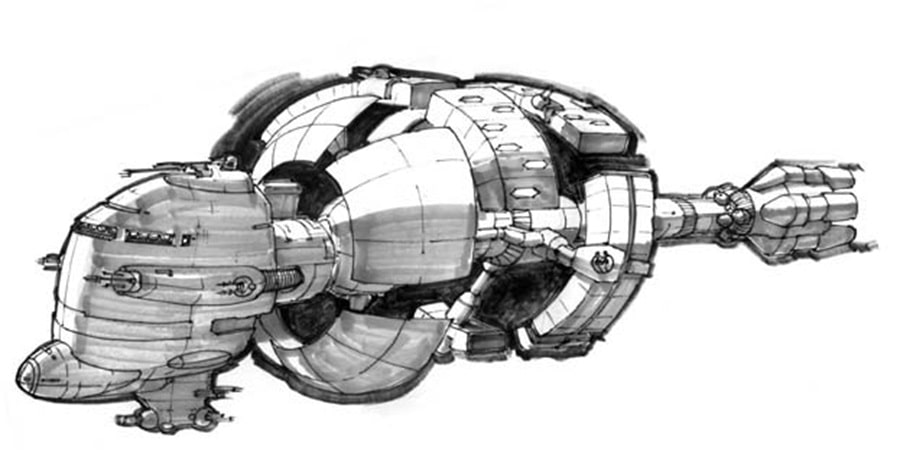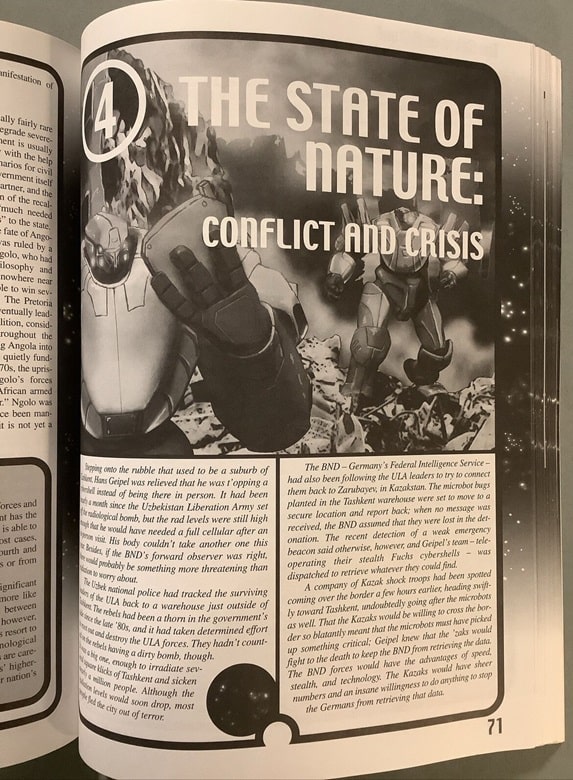A High-Tech Sandbox: Transhuman Space by David Pulver
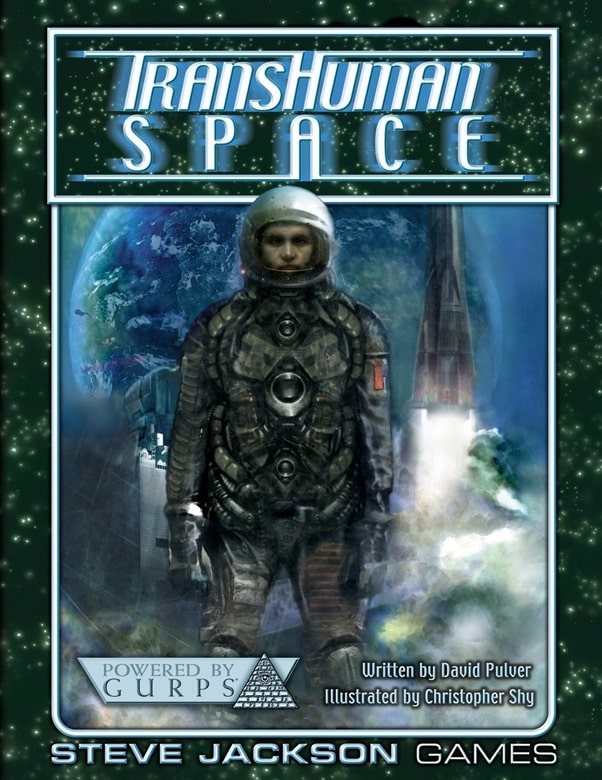 |
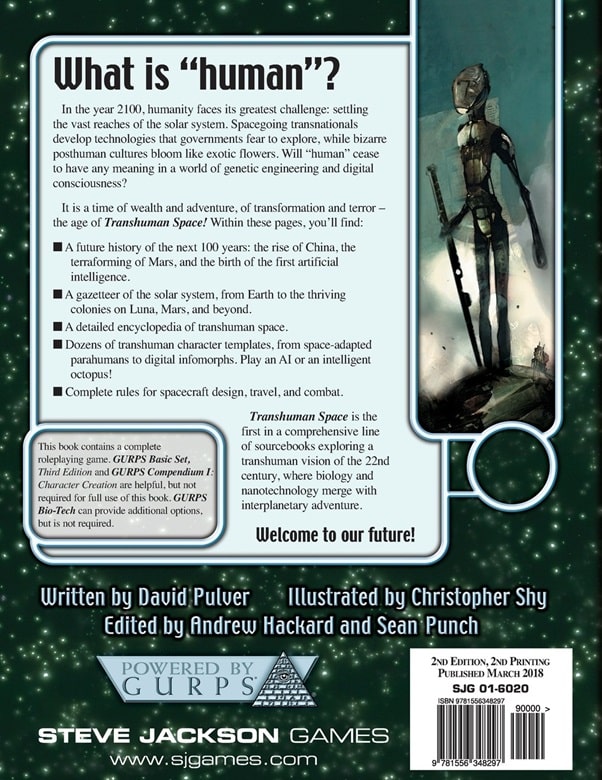 |
Transhuman Space (Steve Jackson Games, March 29, 2018). Illustrated by Christopher Shy
In the 1990s, I made a big decision about tabletop roleplaying gaming: Rather than coming up with my own rules for running games, I ran campaigns using published systems. Some of these used my own original settings; some borrowed settings from published fictional or dramatic works, either as adapted by game publishers or in my own adaptations; and some used published original game worlds. I hardly ever used a setting more than once. But one that I found worth coming back to was David Pulver’s Transhuman Space, a setting for Steve Jackson Games’ game system GURPS.
As its name suggests, Transhuman Space was a science fictional milieu. Tabletop roleplaying has had a lot of these, going back to the classic Traveller, first released in 1977. For a long time, most of them built on the premises of what might be called classic science fiction: The stories of Old Wave authors such as Poul Anderson or Frank Herbert, and of later hard science fiction authors such as Larry Niven, or of the original Star Trek. That is, they were about aliens, robots, supermen, interstellar travel, time travel, parallel worlds, and psionic abilities, singly or in combination.
Transhuman Space does have robots, though they’re quite different from Asimovian robots. But it avoids all those other classic story elements. It has space travel, on an interplanetary (but not interstellar) scale, with human inhabitants from Mercury to the Kuiper Belt — but also with many machines that don’t need life support.
[Click the images for transhuman versions.]
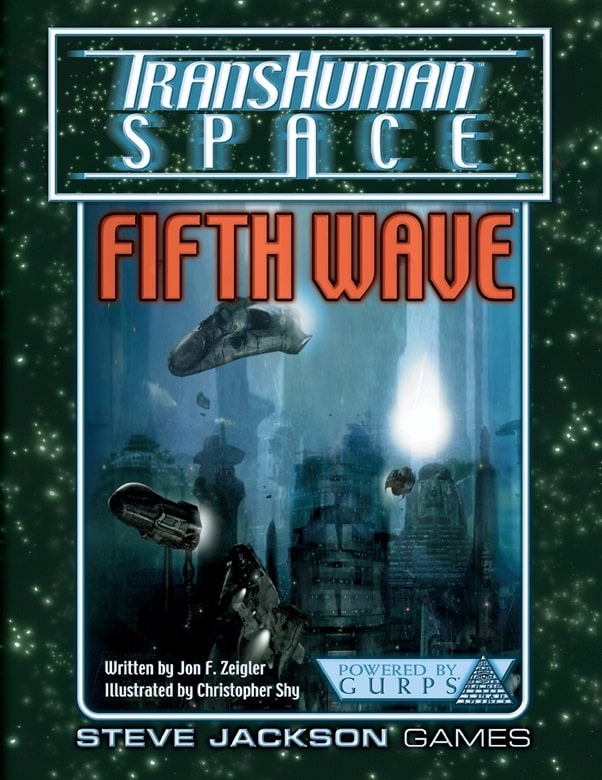 |
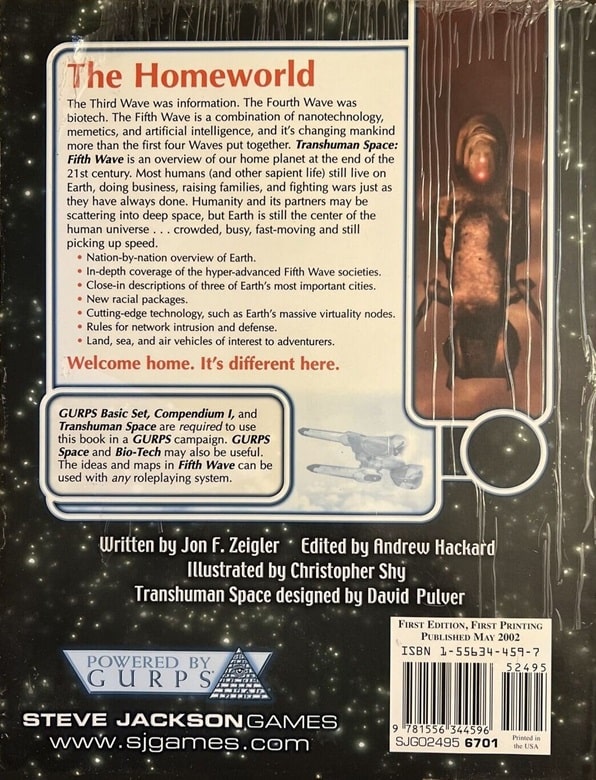 |
Transhuman Space: Fifth Wave by Jon Z. Zeigler
(Steve Jackson Games, March 29, 2018). Cover by Christopher Shy
But it also envisions various other speculative possibilities: human cloning, human genetic modification, nonhuman animals with enhanced intelligence, true artificial intelligence, uploading of human minds into computers, and a science of memetics that greatly enhances both education and propaganda — most of which relate in some way to information.
These developments are what make the setting “transhuman”: they open up possibilities for transforming human beings into something different and for creating nonhuman beings that are humanity’s equals. If you want to play a parahuman with augmented intelligence, or an uplifted dog, or a self-aware computer program, Transhuman Space lets you.
Fitting the focus on information, Transhuman Space’s version of “robots” are combinations of two entities: a digital “infomorph” and a physical “cybershell” on which it runs. Cybershells include what we think of as computers, but also such varied constructs as brain implants, “bush robots” with multiply branching limbs (inspired by a proposal from Hans Moravec), and military vehicles — and even living bodies controlled by internal computers. Infomorphs can migrate from one shell to another. Inspired by fear of an AI takeover, most societies in this setting mandate that AI code include a requirement to obey the law and a specific prohibition on self-copying; “xoxhunters” who track down and delete unauthorized copies are heroes of popular dramatic series.
Transhuman Space concept art
One of the major political tensions of this imagined future is specifically over information. A new ideology, infosocialism, maintains that since the marginal cost of copying information approaches zero, all information ought to be freely available. (This isn’t much of an extrapolation from how many librarians and academics view current scientific publishing.)
Since this makes it impossible to monetize content, infosocialists want governments to subsidize the production of content. One of the future world’s major power blocs, the Transpacific Socialist Alliance (extending from Central and South America to Southeast Asia to Madagascar), adheres to this view — and the backstory of the setting includes a major war between the Alliance and several other powers, notably including China, ironically named the “Pacific War.”
Transhuman Space’s other big political tension is between transhumanism and a rival ideology, preservationism — a view with elements of conservatism, but melded with environmentalism and with caution about modifying the human genome. The heartland of this view is a future European Union; it’s enforced there by a Genetic Regulatory Agency with international powers (players may choose to take the roles of its agents). This, too, has its signature conflict in the backstory: an early and implausibly successful effort to terraform Mars, whose initiators had to flee for their lives to the asteroid Ceres. Anxiety about the destructive effects of technological changes in “human nature” is one of the themes of this game setting.
 |
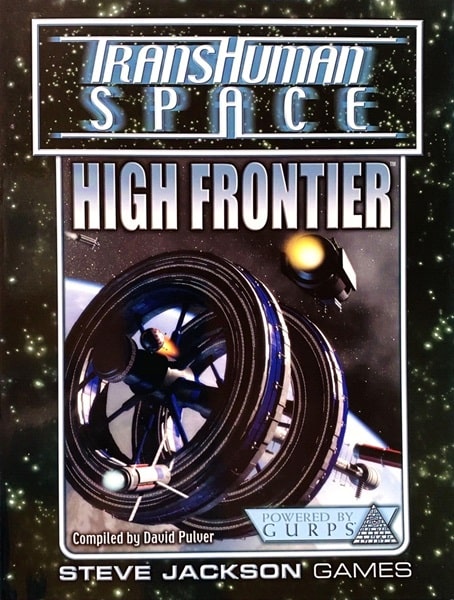 |
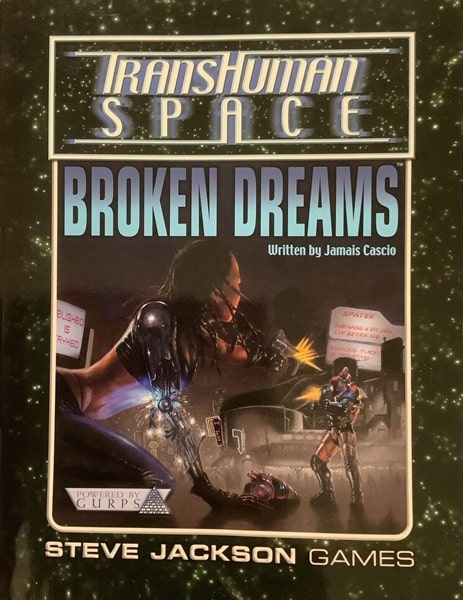 |
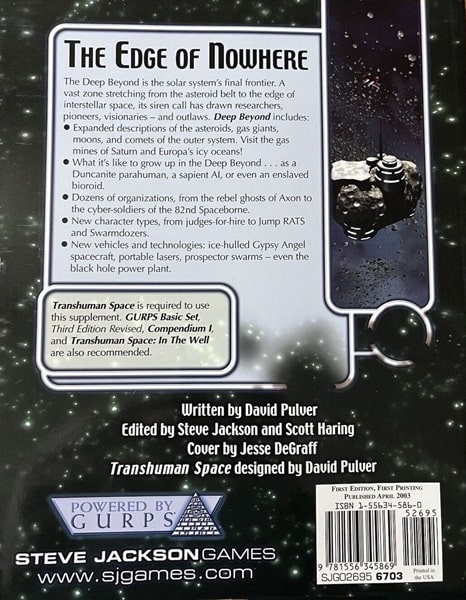 |
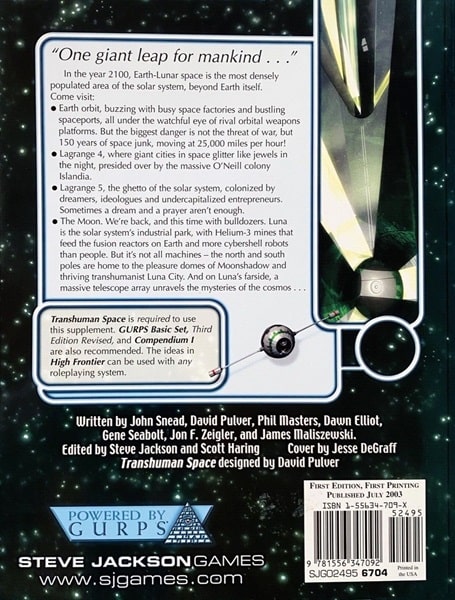 |
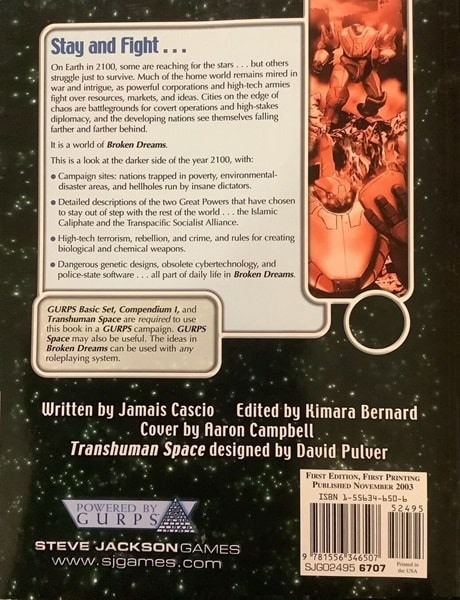 |
Transhuman Space supplements: Deep Beyond, High Frontier, and Broken Dreams.
By David Pulver and Jamias Cascio (Steve Jackson Games, January 15, 2003,
July 24, 2003, and November 15, 2003). Covers: Jesse DeGraff and Aaron Campbell
As it happens, my two campaigns in Transhuman Space more or less focused on these two themes. The first one was a private eye campaign, not about murders, but about informational crimes and torts, ranging from political “whitemail” (using the threat of exposure to pressure influential people into supporting a political cause) to sabotage of a space vessel’s software. This was enlivened by ongoing romantic tension between two of the player characters, with distinctively preservationist and transhumanist sympathies.
The second one was cosmic horror, inspired by Lovecraft — but nearly all of the inhuman threats were actually the products of technological advances! Several of the characters there had old ties going back to the cleanup of autonomous war machines after the Pacific War.
It was initially a challenge coming up with ideas for campaigns; I thought about it for a couple of years before venturing one. Transhuman Space is very far toward the “sandbox” end of the gaming spectrum. Not only does it give the player characters freedom to explore the world; it gives the campaign designer resources to support a wide range of possible campaigns.
The State of Nature (from Broken Dreams)
This is very much in the spirit of GURPS more generally — but the very open-endedness means that the focus and selectiveness have to come from the game master. With not only the original core book but seven full-length supplements, Transhuman Space really was an embarrassment of riches!
One element in the setting that always bothered me (and that my players never wanted to explore) was “bioroids,” a concept apparently borrowed from anime: artificial humanlike beings assembled from engineered tissues on a technological frame, in a rather Frankensteinian style, and narrowly trained as laborers, with limited rights, even in most purportedly free societies. I have to say I found this revival, if not of outright slavery, of indentured servitude, creepy and even dystopian.
A less awkward concept, but one I always had trouble believing in, was “ghosts”: digital simulations of human brains, created by destructive scanning in the style of the recent streamed video series Upload. In the setting it’s taken as a form of survival and even of immortality. I always felt that uploading amounted to committing suicide in order to make a copy of oneself — a form not of survival but of reproduction. It helped that my first set of players chose to play characters who had varied opinions on this subject!
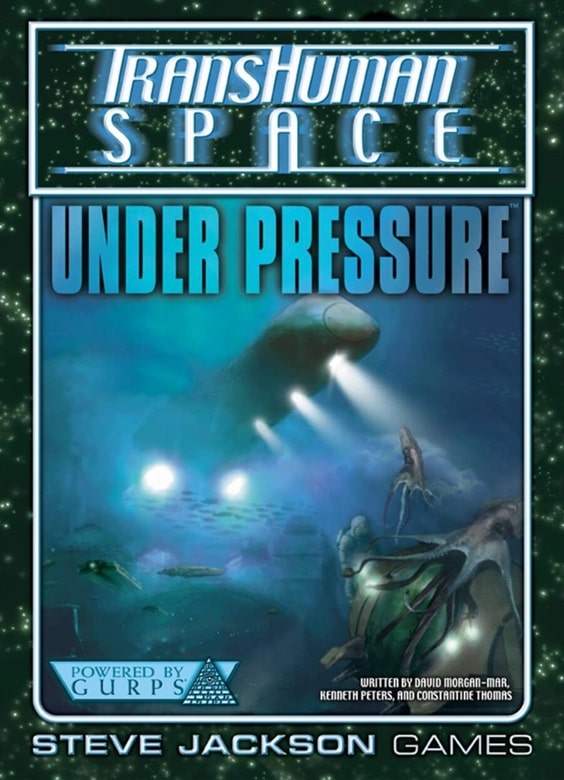 |
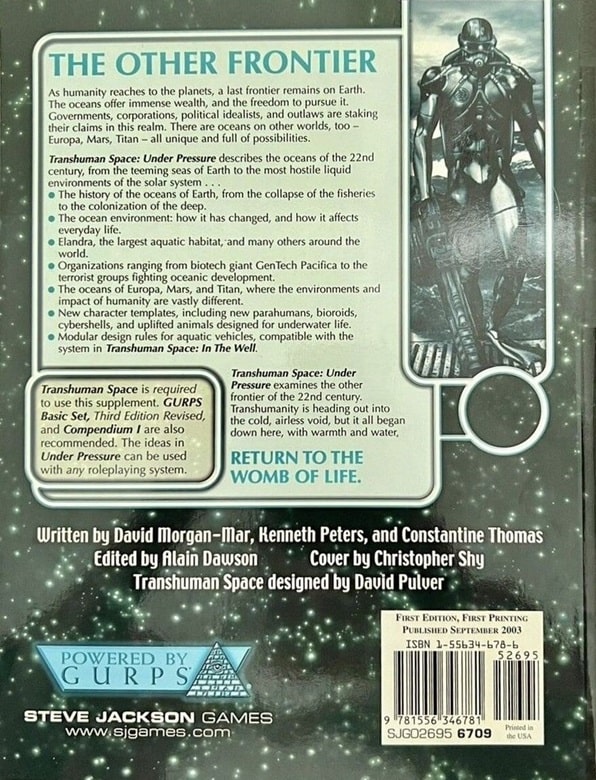 |
Transhuman Space: Under Pressure by David Morgan-Mar, Kenneth Peters,
and Constantine Thomas (Steve Jackson Games, September 19, 2003). Cover by Christopher Shy
How does Transhuman Space stand up now, two decades later? Could it still be used to run campaigns?
On one hand, there’s increasing competition in this genre; several other games have explored transhumanism, post-scarcity societies, and the like. On the other hand, most of these seem to assume faster-than-light travel and rapid interstellar expansion, and in that respect are more like classic science fiction — or perhaps like “new space opera,” a genre that has emerged in roughly the same time frame. I rather like the idea of a campaign focused on our own solar system, and even perhaps largely on a future Earth.
On the other hand, a chronic problem for science fiction worlds is that the real future overtakes their imagined futures, turning them into alternate histories — and campaigns set in them take on a flavor of nostalgia. That nostalgia, for example, practically defines steampunk as a genre.
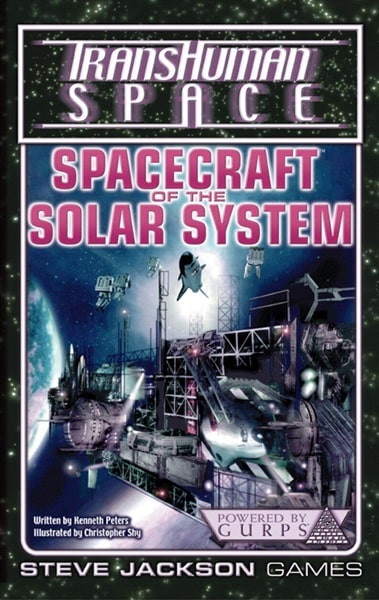 |
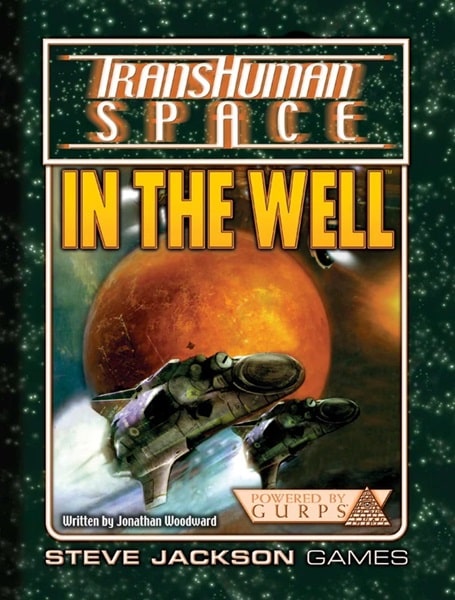 |
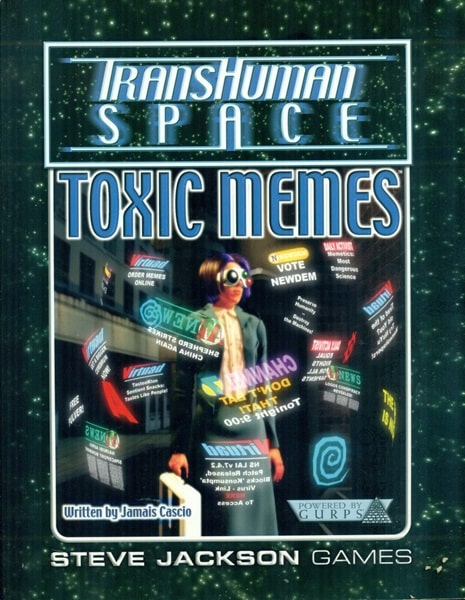 |
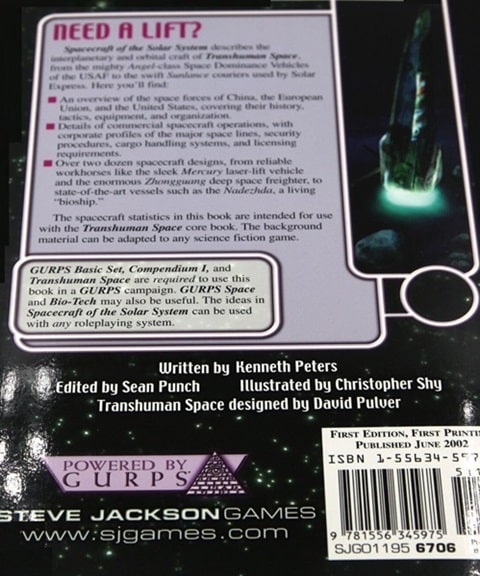 |
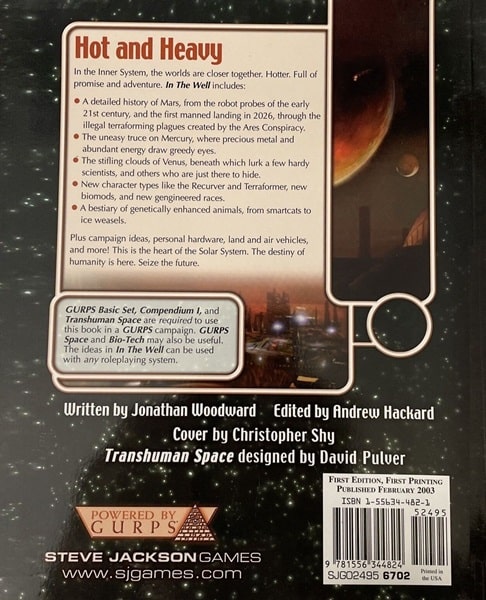 |
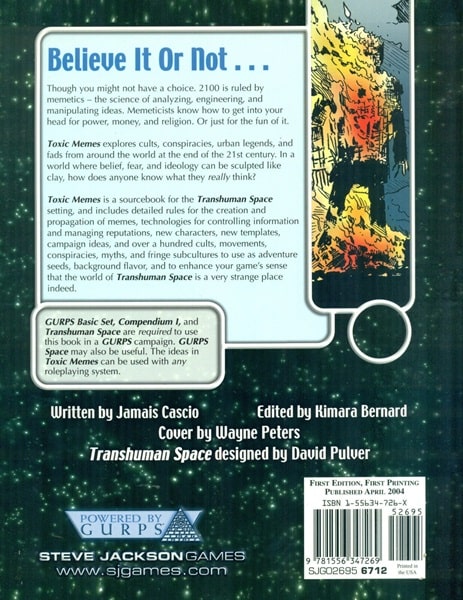 |
Transhuman Space: Spacecraft of the Solar System, In the Well, and Toxic Memes,
by Jonathan Woodward, David Pulver, and Jamais Cascio (Steve Jackson Games, July 1,
2002, February 15, 2003, and April 26, 2004). Covers: Christopher Shy and Wayne Peters
But before old science fiction takes on a romantic haze, it has a period of awkwardness. A lot of historical details would have to be glossed over; for example, Transhuman Space’s European Union not only still includes the United Kingdom, but has expanded to take in several Canadian provinces; its China and Taiwan, and its North and South Korea, peacefully reunified by 2022 and 2025. China’s landing on Mars in 2026 seems unlikely, and the wild success of Martian terraforming was never easy to believe.
Even so, Transhuman Space was a richly detailed setting; if it had imperfections, it had enough depth to make up for them. I think it has the potential to become a classic in its field. Perhaps a campaign set in its default start year of 2100 could leave the early twenty-first century blurry enough to avoid obvious incongruities.
But perhaps it might serve better as inspiration for a new imagined future. Certainly its success in coming up with novel conflicts that emerge from the logic of its setting, rather than simply projecting our own conflicts forward, is an achievement worth emulating.
William H. Stoddard is a professional copy editor specializing in scholarly and scientific publications. As a secondary career, he has written more than two dozen books for Steve Jackson Games, starting in 2000 with GURPS Steampunk. He lives in Lawrence, Kansas with his wife, their cat (a ginger tabby), and a hundred shelf feet of books, including large amounts of science fiction, fantasy, and graphic novels. His last article for us was a review of Odd John by Olaf Stapledon.
